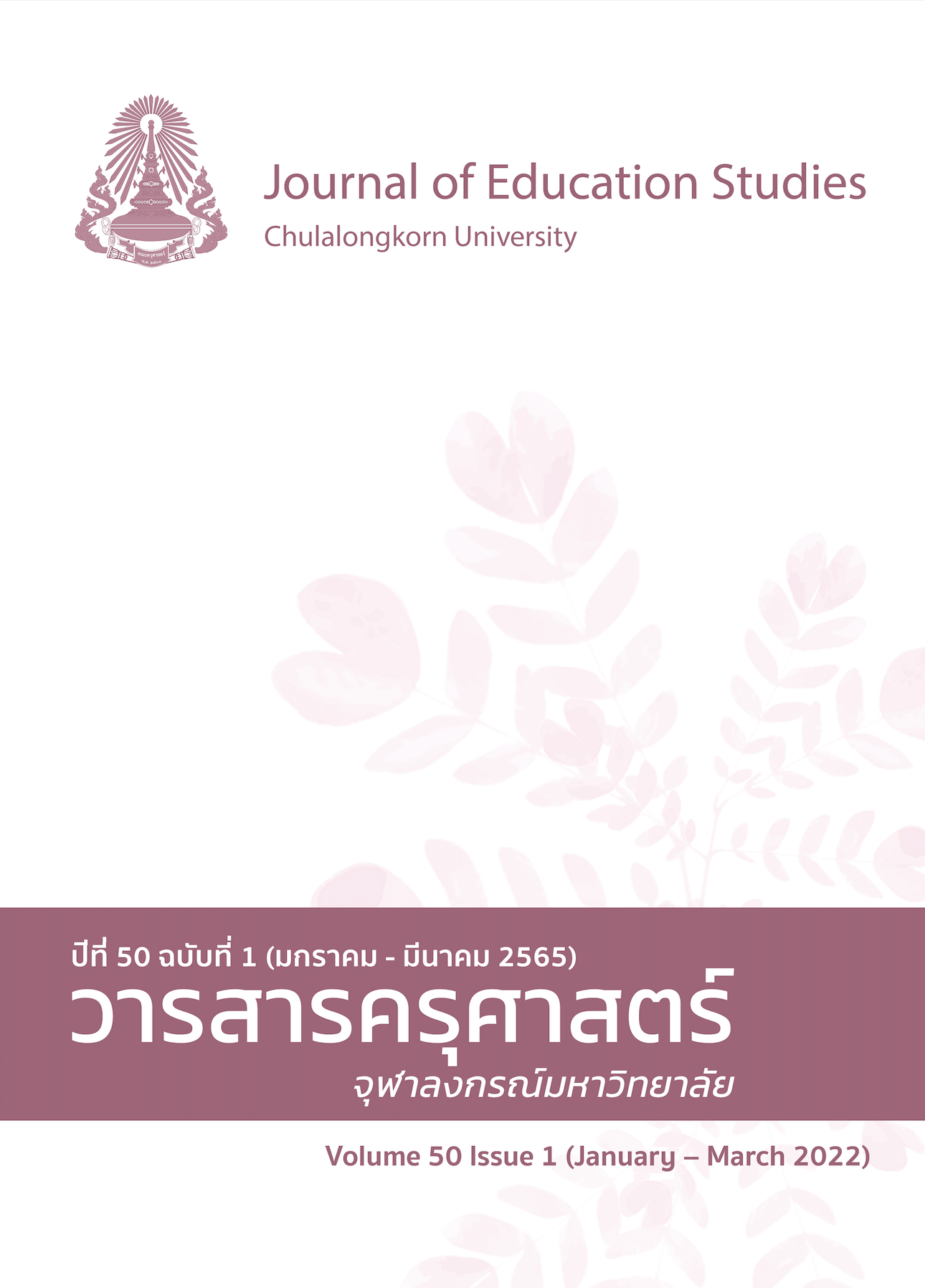The Development of English Writing Ability by Using the B-SLIM model with the CIRC Technique for Students in Secondary level 1
DOI:
https://doi.org/10.14456/educu.2022.4Keywords:
English writing ability, the B-SLIM model, CIRC technique, secondary levelAbstract
The objectives of this research were 1) to compare the English writing ability of students at secondary level 1 before and after learning management by using the B-SLIM model with the CIRC technique, 2) to study group working behavior that was managed by using the B-SLIM model with the CIRC technique; and 3) to study the satisfaction of students towards the teaching method of the B-SLIM model with the CIRC technique. The sample group was 40 students in secondary level 1 by using cluster sampling. Research instruments consisted of an English writing ability test, an observation form for group working behavior of students, and a questionnaire on student satisfaction with the learning management method. The statistics used were mean, standard deviation and t-test. The results showed that 1) the English writing abilities of students in secondary level 1 after studying with the learning management method were higher than they were before with a statistically significant difference at .05 level; 2) the students’ group working behaviors during the learning management, overall, were at a high level; and 3) the students' overall satisfaction with learning by using the B-SLIM model with the CIRC technique was found to be at the greatest possible level.
References
ภาษาไทย
ทิศนา แขมมณี. (2561). ศาสตร์การสอน (พิมพ์ครั้งที่ 21). โรงพิมพ์จุฬาลงกรณ์มหาวิทยาลัย.
นิรมล น้อยจันทร์. (2554). การพัฒนากิจกรรมการเรียนรู้ด้านการอ่านจับใจความ กลุ่มสาระการเรียนรู้ภาษาไทย สำหรับ
นักเรียนชั้นประถมศึกษาปีที่ 3 โดยใช้เทคนิค CIRC. Journal of Education, 12(6), 70-79.
ปริวรรต สมนึก. (2558). การพัฒนานวัตกรรมการเรียนการสอนโดยใช้สื่อวีดิทัศน์เพื่อเพิ่มผลสัมฤทธิ์ทางการเรียนเรื่อง
ผลิตภัณฑ์การท่องเที่ยว. Journal of International and Thai Tourism, 11(1), 4-17.
ปารณัท ศุภพิมล. (2561). การใช้การสอนแบบบีสลิมเพื่อส่งเสริมทักษะทางภาษาอังกฤษของนักเรียนชั้นมัธยมศึกษาปีที่ 2.
Journal of Education Naresuan University, 20(3), 130-140.
ปิยวรรณ รุ่งวรพงศ์. (2557). ปัญหาการเขียนภาษาอังกฤษของนักศึกษาใหม่ : กรณีศึกษามหาวิทยาลัยสงขลานครินทร์
วิทยาเขตตรัง. RMU.J. (Humanities and Social Sciences), 8(3), 119-126.
พระราชบัญญัติการศึกษาแห่งชาติ พ.ศ. 2542 และที่แก้ไขเพิ่มเติม (ฉบับที่ 2) พ.ศ. 2545. (2542, 14 สิงหาคม).
ราชกิจจานุเบกษา. เล่ม 116 ตอนที่ 74 ก. หน้า 13.
พิชญา สารถี. (2553). การศึกษาผลสัมฤทธิ์ทางการเรียนภาษาอังกฤษของนักเรียนชั้นประถมศึกษาปีที่ 4 ที่ได้รับการจัด
การเรียนรู้โดยรูปแบบ B-SLIM [วิทยานิพนธ์ปริญญามหาบัณฑิต, ไม่ได้ตีพิมพ์]. มหาวิทยาลัยราชภัฏนครราชสีมา.
วิรัญชนา ใจสม. (2561, 18 ตุลาคม). ความสำคัญของภาษาอังกฤษในห้องเรียนยุค ๔.๐. ThaiJo. http://ejournal.nidtep.go.th/PDF/pdf5be2aa21d52dc.pdf
ศิริรัตน์ มงคล. (2553). การพัฒนาการเรียนรู้ภาษาอังกฤษเพื่อการสื่อสารโดยใช้ B-SLIM Model ของนักเรียนชั้นมัธยมศึกษา
ปีที่ 1 [วิทยานิพนธ์ปริญญามหาบัณฑิต, ไม่ได้ตีพิมพ์]. มหาวิทยาลัยมหาสารคาม.
สริตา บัวเขียว. (2561). ความสามารถในการเขียนประโยคภาษาอังกฤษพื้นฐานโดยใช้แบบฝึกทักษะไวยากรณ์ภาษาอังกฤษ
เรื่อง Sentence Building สำหรับครูผู้สอนวิชาภาษาอังกฤษระดับประถมศึกษาที่ไม่ได้สำเร็จการศึกษาสาขาวิชา
ภาษาอังกฤษ จังหวัดเพชรบุรี. ใน เรื่องเต็มการประชุมทางวิชาการของมหาวิทยาลัยเกษตรศาสตร์ ครั้งที่ 56 : สาขา
ศึกษาศาสตร์, สาขาเศรษฐศาสตร์และบริหารธุรกิจ, สาขามนุษยศาสตร์และสังคมศาสตร์ (น. 230-237). สำนักงาน
กองทุนสนับสนุนการวิจัย.
สุจิตตรา สิงหการ. (2555). เทคนิคการเรียนรู้เพื่อพัฒนาทักษะการเขียนภาษาอังกฤษ. วารสารศึกษาศาสตร์ มหาวิทยาลัยสุโขทัยธรรมาธิราช, 2012(1). 164-165.
สุพรรษา ทิพย์เที่ยงแท้. (2557). การพัฒนาแบบฝึกทักษะการเขียนภาษาอังกฤษเพื่อการสื่อสารโดยใช้ข้อมูลท้องถิ่นชะอำ
สำหรับนักเรียนชั้นประถมศึกษาปีที่ 4 [วิทยานิพนธ์ปริญญามหาบัณฑิต, ไม่ได้ตีพิมพ์]. มหาวิทยาลัยศิลปากร.
สุภาพร พันเหลา. (2560). การวิจัยและพัฒนาแบบฝึกทักษะการเขียนภาษาอังกฤษเพื่อการสื่อสาร สำหรับนักเรียน
ชั้นมัธยมศึกษาปีที่ 1 [วิทยานิพนธ์ปริญญามหาบัณฑิต, ไม่ได้ตีพิมพ์]. มหาวิทยาลัยราชภัฏมหาสารคาม.
อารยา วิโรจน์. (2562). การพัฒนาการอ่านคำยากของนักเรียนชั้นประถมศึกษาปีที่ 2 โดยใช้การเรียนรู้แบบร่วมมือเทคนิค
CIRC ประกอบแบบฝึก [วิทยานิพนธ์ปริญญามหาบัณฑิต, ไม่ได้ตีพิมพ์]. มหาวิทยาลัยราชภัฏมหาสารคาม.
อรัญญา ราชการกลาง. (2561). การพัฒนารูปแบบการสอนแบบ B-SLIM โดยบูรณาการเทคนิคการสอนแบบเพื่อนคู่คิดและ
ประยุกต์ใช้วิดีทัศน์ ในรายวิชาภาษาอังกฤษพื้นฐาน 3 สำหรับนักเรียนชั้นมัธยมศึกษาปีที่ 2. วารสารวิชาการ
การจัดการเทคโนโลยีสารสนเทศและนวัตกรรม. 2561(5), 73-87.
อภิรักษ์ โต๊ะตาหยง และ อริยา คูหา. (2554). ผลของการสอนโดยการเรียนแบบร่วมมือแบบบูรณาการการอ่านและการเขียน
(CIRC) ที่มีต่อผลสัมฤทธิ์ด้านการอ่านแบบการเขียนภาษาอังกฤษของนักเรียนสองภาษา. วารสารมหาวิทยาลัย
นราธิวาสราชนครินทร์. 2011(2), 65-80.
ภาษาอังกฤษ
Bilash, O. (2000). Bilash’s success-based langauge instruction model (B-SLIM). New Direction. https://lunarlynn.wixsite.com/lunarlynn/b-slim-cee5.
Harris, D. P. (1974). Teaching English as a second language. McGraw Hill.
Johnson, D. W., & Johnson, R. T. (1987). Cooperation and Competition: Theory and Research.
Interaction Book.
Raimes, A. (1983). Techniques in teaching writing. Oxford University.
Ur, P. (2004). A course in language teaching: Practice and theory. Cambridge University Press.
Downloads
Published
How to Cite
Issue
Section
License

This work is licensed under a Creative Commons Attribution-NonCommercial-NoDerivatives 4.0 International License.




